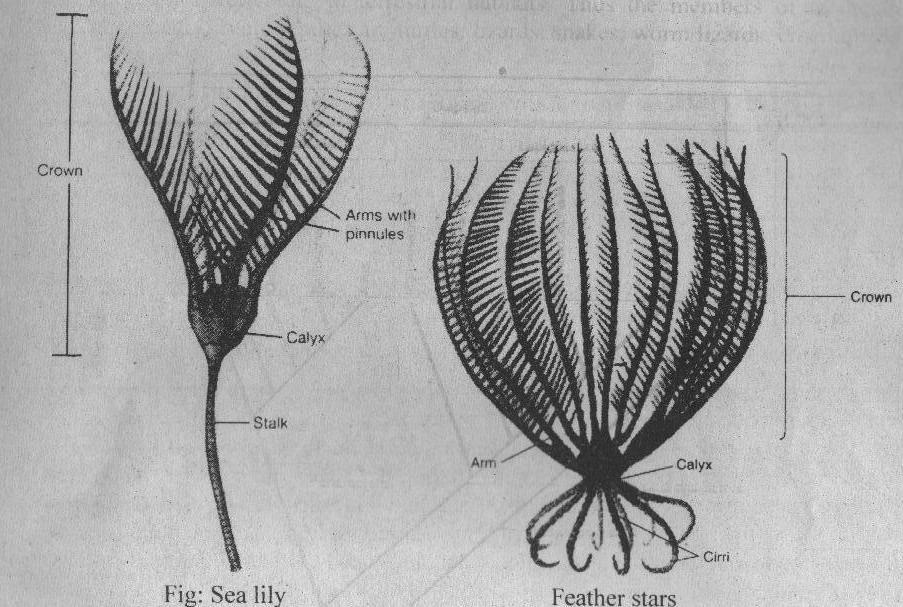CLASS CRINOIDEA (krinon, lil + oekks, in the form of)
Class Crinoidea includes the sea lilies and the leather stars. They are the most primitive living echinodemis. Therefore, they are very different from all other echinoderms. Their 630 species are living today. But fossil record shows that they have large number of species in Paleozoic era, 200 to 600 million years ago.
Sea lilies
Sea lilies attach permanently to their substrate by a stalk. The attached end of the stalk bears a flattened disk. This disk is root like extensions. It fixed the body to the substrate. Disk like ossicles of the stalk are stacked on one another. They are held together by connective tissues. It gives a jointed appearance. The stalk bears projections or cirri. These cirri are arranged in whorls. The unattached end of a sea lily is called the crown. The aboral end of the crown attaches to the stalk. It is supported by a set of ossicle. called the calyx. Five arms also attach at the calyx. They are branched, supported bv ossicles. These arms bear smaller branches called pinnules. It gives a feather like appearance. Tube feet are present in a double row along each arm. .Ambulacral grooves on the arms lead toward the mouth. The mouth and anus open onto the upper oral surface.
Feather stars
Featherl stars are similar to sea lilies. But they lack a stalk. They are swimming and crawling animals. The aboral end of the crown bears a ring of root like cirri. These cirri cling to the substrate during rest. Feather stars swim by raising and lowering the arms. They crawl over substrate by pulling the tips or the arms.
MAINTENANCE FUNCTIONS
Circulation, gas exchange. and excretion in crinoids arc similar to these Functions in other echinoderms. However, crinoids use outstretched arms in feeding. Thev are suspension feeder. The tube foot traps any planktonic organism which touches it. The cilia in ambulacral grooves carry it to the mouth. This method of feeding is different from the feeding of modern echinoderms. But it shows the original function of the water vascular system.
Crinoids lack the nerve ring. Acup-shaped nerve mass is present below the calyx. It gives tise to radial nerves. Radial nerves extend through each arm. These nerves control the tube feet and arm masculature.
REPRODUCTION AND DEVELOPMENT
Crinoids are dioecious. Gametes arc formed by germinal epithelium in the coelom. They are released by the rupturing the walls of the arms. Some species spawn in seawater. Fertilization and development occur in water. Some species brood embryos on the outer surface of the arms. The larvae are attached to the substrate and metamorphosis occurs. Crinoids can regenerate lost parts.

